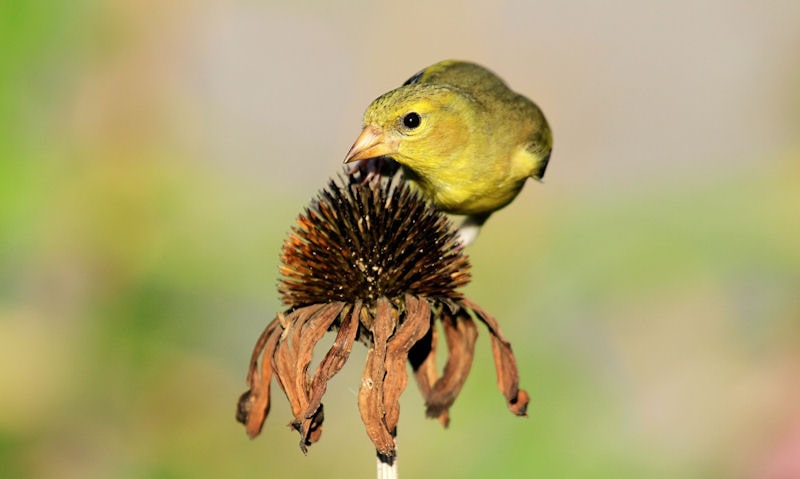What do American Goldfinch eat
Goldfinches are birds that feed at an elevated point so their diet mostly consists of food that must be foraged in trees or low down in shrubs or weeds.
What do American Goldfinches eat is seeds, mostly made up of the daisy family. Seeds can be extracted from trees, including those in cones. Buds on branches are eaten and so too is bark of young twigs. Maple sap can be ate on occasion and so too insects in summer. Goldfinches will happily come to feeders.
To know what do American Goldfinches eat can allow you to identify what exactly are the bird species occupying your flower beds in the backyard.
However, the distinctive bright yellow coloring of Goldfinches don't need much help, as those black marks will surely help you identify which is and isn't the American Goldfinch.
As American Goldfinches diet is made up of seeds, its only this part contained within young or blooming flowers, the Goldfinches will eat. Seeds available to them can also include those belonging to weeds and grasses.
So to are seeds buried in cones or buds before they bloom into flowers or leafs.
Incredibly, the Goldfinch will forage in a tree for the bark of a young branch, but rarely.
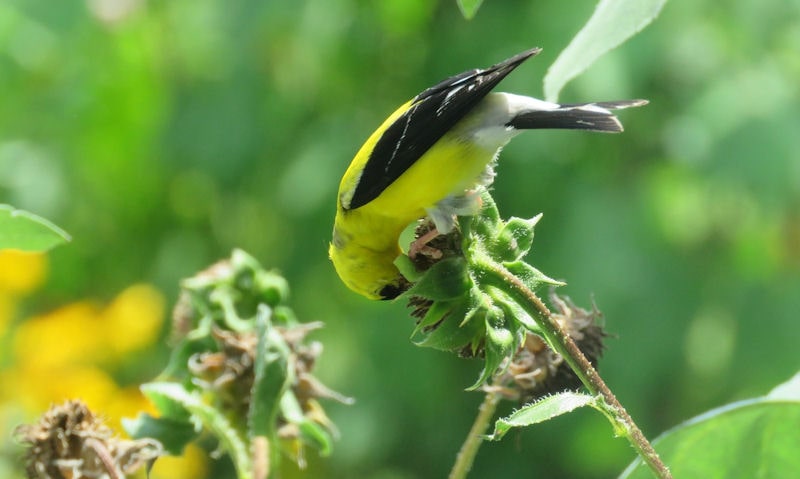
What I believe you can relate to with its sweet yet sticky texture is that of maple sap Goldfinches eat from oozing trees.
While the American Goldfinches diet consists mostly of seeds, that is not to say it won't forage for seeds but happily eat insects if stumbled upon.
What Goldfinches will eat that we can recognize ourselves in our own seed bird feeders are seeds belonging to sunflowers or thistles.
Goldfinches would normal stop eating seeds of plants in breeding season while they switch over their diet to more protein rich natural foods.
Mostly the daisy flower family
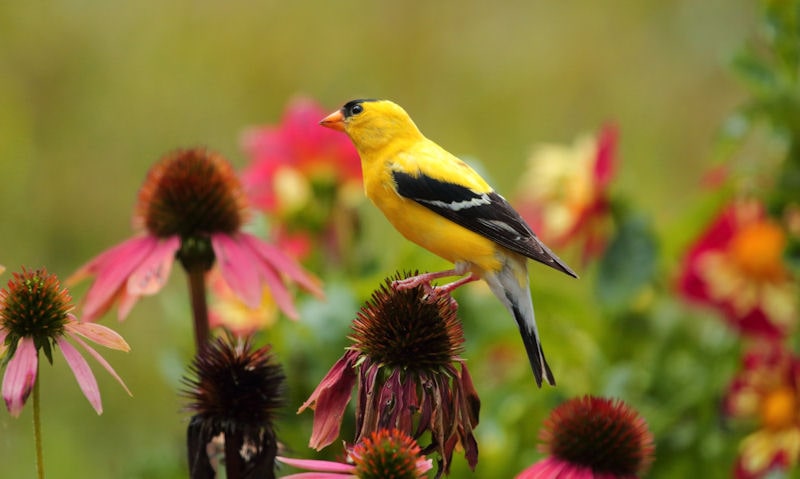
No shortage of what American Goldfinches eat in the wild, that's for sure - as the species mostly feed on the daisy family.
What that can consist of is a mix of flowers that belong under the daisy name.
It can be referred to as the aster, composite or sunflower family, but what it basically is are a very common, very large and widespread family of flowering plants throughout the United States.
While American Goldfinches and you for that matter would relate to sunflowers and thistles, other flowers can include: lettuce, chrysanthemums, asters, dandelions, goldenrod, coneflowers, artichokes, dahlias, marigolds, zinnias, chamomile, chicory, sage, tarragon, ragweed, sagebrush and yarrow.
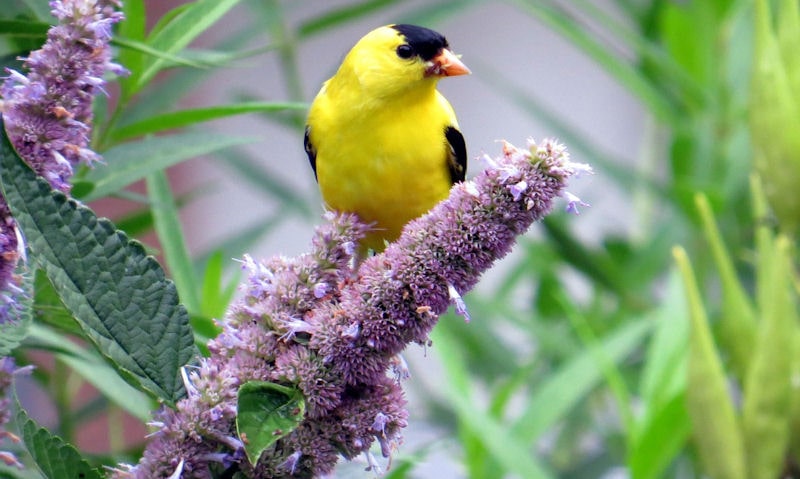
Lettuce may be something that seems unusual for birds, but Goldfinches would primarily feed on the seeds, not the lettuce leafs itself.
Daisies grow in springtime, lasting several months before Goldfinches move on to other seeds in season or insects more in cooler days.
Seeds of trees
While American Goldfinches will feed on huge amounts of daisies in the nicer weather, there comes a time when their dietary intake moves onto more readily available feed.
Up next but also eaten simultaneously with daisies if available to them, Goldfinches will actually feed on seeds of trees; including elm, birch and alder - found in their natural habitat of course.
To eat on seeds of trees, the seeds are not found on or in the ground as you may think, but rather the Goldfinch will forage for them in the borne on trident bracts in the cone, growing off tree branches.
American Goldfinches are traditionally non-ground feeding birds so would forage at a higher point within shrubs, weeds and trees.
Tree seeds can be consumed throughout summer before the cones drop to the ground later on - often where people collect cones in bags or baskets.
Buds, bark or twigs
Goldfinches will also take to feeding on bark of young trees only and buds that can be seen on the stem of a vascular plant.
Benefit for birds eating buds fresh on the stem is they are lignified tissues for conducting water and minerals throughout the plant, so offer valuable nutrients.
Any type of bud will later on blossom into flowers, leafs or shoots.
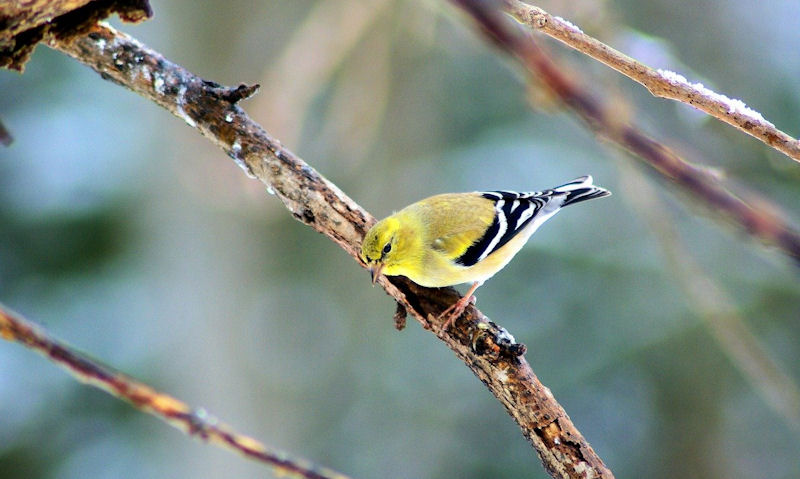
Goldfinches will only take to eating the young bark of trees with the mature kind not suitable for consumption.
At this point the bark is pecked out deeper into its flesh rather than biting on a random part of the young, soft bite twig bark.
Relatable maple sap
In early springtime or late winter the weather can do marvelous things to trees, thus the maple sap can begin oozing out of trees.
Maple trees of cause but there's huge benefits to Goldfinches in this time of year.
And of course the raw maple sap is what we as people will use once its been processed, to then be poured over our pancakes or pastries - only American Goldfinches get it all for free.
Benefits to maple if Goldfinches are lucky to find it, contains vital minerals and is made up of 97.5% water - thus allowing Goldfinches to consume much needed liquids.
However, a word of warning is to never feed maple syrup to birds out of your home.
It may be possible to offer the raw maple sap while spreading it on tree bark, but while the sugar content is good for Goldfinches, be warned - it can attract bugs and insects.
Rarely insects in summer
Goldfinches may find their abundance of seed soon become a little more scarce but still available in summertime, through natural loss or change in habitat.
But for Goldfinches to begin the process of eating insects, it can only be summer, when they are plentiful within trees and shrubs.
Insects can include spiders, maybe beetles, butterflies or crickets; whereas flying insects such as bees cannot be caught on the fly - but will be eaten if caught on the ground.
Insects can make up the Goldfinches diet for an extended period of time in summer, but seeds are still widely eaten.
Rare as it is for American Goldfinches to eat insects but when they do the nutritional value that insects offer is a protein rich meal.
Perfect then as protein is needed as birds approach the spring for breeding season.
Eats seeds at feeders
Make no mistake when feeding Goldfinches in your yard, as the breed would rather take to seed feeders over any other kind of bird feeder, such as peanuts or suet feeders.
It can be a hanging tube seed feeder, netted, a hopper style feeder, or an elevated platform feeder, but too add seeds to feeders with perches would be preferred by Goldfinches.
On another note there will be no issues for American Goldfinches re-hydrating in a bird bath setup if there is lack of water source in nature.
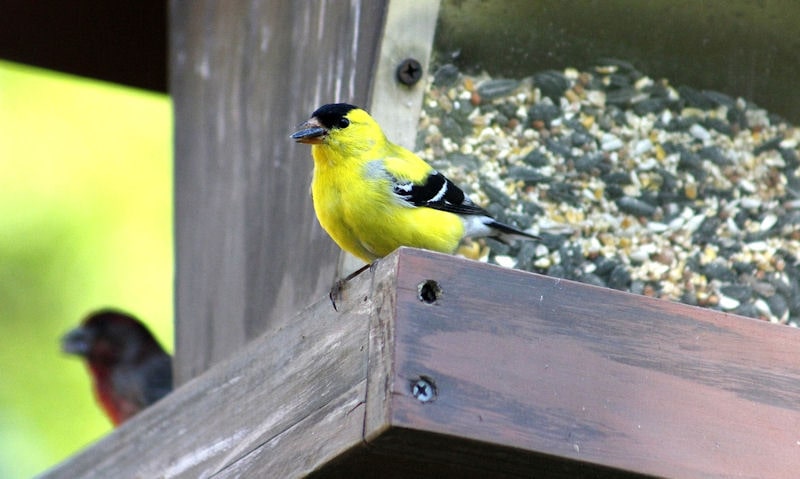
More importantly, its this kind of seeds Goldfinches prefer over others that you must be sure to replenish your feeders with.
What wild bird seeds you can use in bird feeders for Goldfinches is the ever popular sunflower or thistle, including Nyjer seeds.
American Goldfinches actually eat thistle and sunflower seeds in nature, so to offer this type of seeds would be a favorite.
Young Goldfinches fed on seeds
Depending on the time of the year and what the mother is feeding on at the time, the young American Goldfinch back in the nest will be fed on mostly regurgitated seeds.
It could also be made up of insects and other matter, like feed found at the feeder.
Not all backyard birds can regurgitate their food but that is not true with the American Goldfinch - as its a method used to hold food for feeding their youngsters later.
But as a rule of thumb, young birds will eat whatever their mother is eating.
Later on once the youngsters leave the nest with their mother, they can begin the process of eating seeds at bird feeders, in which it has to be fed to them by adult birds.
Young American Goldfinches can be fed the wrong thing at their nests if there parents bring back food fed to them that can cause choking hazards.
Summarize
American Goldfinches are a bird species with a diet made up of mostly seeds, or any kind of seed matter for its young.
Most consumed flower seeds would be that of the sunflower or thistle seeds known more to us - but other seed types can include: hyssops, dandelions, goldenrod, coneflowers, artichokes, dahlias, marigolds, zinnias, chamomile, chicory and more.
Other seeds American Goldfinches will eat in their droves but in smaller quantities is that of elm, birch and alder - found higher up in trees such as in cones.
Goldfinches can also take to eating buds and even bark of young twigs.
What the tastiest food Goldfinches will eat on a rare occasion is maple sap, in time when the weather drastically changes, thus forcing the tree to ooze out its maple.
Insects can be eaten for sure but rarely do they, but in summer its spiders and other bugs that will end up being eaten.
Thankfully, us as bird lover's get to enjoy the distinctive yellow plumage of the American Goldfinch - so therefore its important to feed them what they need.
Fill bird feeders with thistle, nyjer or sunflower seeds in a specialty feeder of their own; if not there's an option to use a universal seed feeder or simply pile up seeds on a surface around the backyard or on a platform feeder.
Parenting Goldfinches will feed mostly regurgitate seeds to their young at the nest.
